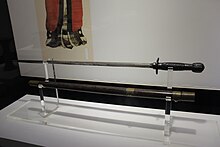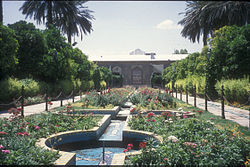어쌔신 메이스
Assassin's mace
암살자의 메이스(중국어: 杀手锏어; 피닌어:샤시 ǒ우지 ǎn)는 전설적인 고대 중국 무기입니다.지금은 중국의 특정 무기 체계를 은유적으로 설명하는 데 사용되고 있습니다.이 용어는 고대 중국의 민속에 뿌리를 두고 있는데, 이것은 어떻게 그런 무기를 휘두르는 영웅이 훨씬 더 강력한 적수를 물리칠 수 있었는지를 이야기하는 것입니다.암살자의 이름을 딴 메이스는 전투에서 적의 칼날을 부수는 데 사용되는 곤봉이거나 적의 갑옷을 통해 충격을 줄 수 있는 핸드 메이스였습니다.미국 군사 전문가들은 중국에서 미국에 대항하기 위한 비대칭전과[note 1] 반접근/지역 거부 능력을[note 2] 보여주는 특정 유형의 군사체제를 설명하기 위해 이 용어를 사용하고 있다고 말합니다.암살자의 메이스가 정부가 정의한 무기 종류를 의미하는지, 아니면 단지 중국 정부에서 이 무기들을 묘사하는 데 사용되는지는 논란의 여지가 있습니다.
어원
샤쇼지안이라는 용어는 문자 그대로 '죽여라', '손', '매이스'라고 번역할 수 있는 세 글자로 구성되어 있습니다.그러나 이러한 문자의 조합은 영어로 번역될 때 종종 다른 방식으로 해석됩니다(중국어에는 두 개의 문자로 된 단어가 많기 때문에). 1996년부터 2005년까지 외국 방송 정보국에서 15개 이상의 다른 번역을 사용했습니다.[1][2]: 311–312 일반적으로 shashoujian은 영어로 'assassin's mace'로 표현되는데, 여기서 두 문자 합성어 shashou는 'assassin'으로, jian은 'mace'로 해석됩니다.[2]: 313 하지만, 그 용어는 '킬링 매이스'로 번역될 수도 있는데, 그 단어인 쇼젠은 고대 중국에서 중무장한 적들을 죽이기 위해 사용된 작은 손 매이스를 가리키기 때문입니다.[2]: 314 샤쇼지안(shashoujian)이라는 용어의 명확한 기원은 명확하지 않지만, 그 용어는 일반적으로 더 강력한 적을 이기기 위해 사용되는 놀라운 힘의 비밀 무기를 설명하기 위해 사용되는 중국 민속에 뿌리를 두고 있습니다.[3][2]: 316
현대 용법
말의 인물이라는 용어는 수세기 동안 존재해 왔으며 현대 중국 대중 문화에서 부활한 반면, 주요 논쟁 중 하나는 현대 군사적 맥락에서의 그것의 사용에 관한 것입니다.[4]이 용어는 중국 군사 상황에서 새로운 무기 체계를 설명하기 위해 자주 사용되며, 군사 분석가인 Bruzdzinski와 Michael Pillsbury는 이 용어를 중국이 우월한 적에 대항하기 위해 고안된 새로운 종류의 무기를 나타내기 위해 사용하는 기술 용어로 해석합니다.[2]: 312 [4]이와 대조적으로 앨러스테어 존스턴(Alastair Johnston)은 영어 관용구인 "실버블렛(silver bullet)" 또는 "트럼프 카드(trump card)"와 거의 동등한 대중적인 표현이며 성공을 보장하는 모든 것을 의미한다고 설명하면서 이 깊은 의미에 이의를 제기합니다.[5][6]
군사 시스템에 적용
중국의 군사적 발전을 설명하기 위해 암살자라는 용어를 사용하는 것에 찬성하는 사람들은 중국 정부가 미국에 대항하고 미국을 세계 강대국으로 대체하기 위해 특별히 고안된 일련의 기술이나 전략을 설명하기 위해 이 용어를 사용한다고 말합니다.[7]러시도시는 인민해방군 전략가들이 세계 초강대국 미국을 대체하기 위해 이 무기들의 개념을 개발했고, 이 개념을 충족시키기 위해서는 인민해방군 해군 잠수함부대, 해상지뢰, 대함 탄도미사일의 개발이 필요하다고 제안했습니다.[8]: 69–70 도시와 브루즈진스키는 암살자의 메이스가 비대칭전술과 반접근/지역거부전술에 초점을 맞춘 것으로 묘사했습니다.[8]: 69 [2]: 342
대전략
도시는 그의 책 The Long Game에서 중국이 미국을 제치고 세계의 지배적인 군사 및 경제 초강대국이 되려 한다고 주장합니다.[8] 그는 이것을 천안문 광장 학살, 걸프전, 그리고 중국에 대한 주요 위협에 대한 잠재적인 협력자에서 미국에 대한 중국의 관점을 바꾼 소련의 해체라는 그가 말하는 "외상적인 3가지 효과"에 대한 반응으로 모델링합니다.[8]: 48–51 도시의 관점에서, 천안문 광장 학살에 대한 미국의 반응은 미국이 중국의 정치 체제를 약화시키기를 원했고, 이라크가 걸프전에서 일방적으로 패배한 것은 미국이 중국을 물리칠 군사적 능력을 가질 수 있다는 것을 보여주었고, 소련의 종말은 사회주의 국가로서 중국을 거의 세계에 홀로 남겨놓았습니다.[8]: 51–53 도시는 이것이 중국군이 미국의 전통적인 우월성에 대항할 수 있는 암살자의 무기를 개발함으로써 미국에 대항하여 방향을 바꾸게 했다고 말합니다.[8]: 69
잠수함

Doshi와 Bruzdzinski는 잠수함이 암살자의 무기체계의 핵심 요소라는 것에 동의하지만, 그들이 그러한 패러다임에 어떻게 들어맞는지에 대해서는 다른 이유를 제시합니다.[8]: 83–86 [2]도시는 암살자의 메이스 잠수함을 대함미사일과 해상지뢰를 이용해 미국 항모전단을 공격할 수 있는 반면 지상공격 능력은 취약하다고 설명했습니다.[8]: 86 도시가 보기에 암살자의 메이스 개념은 핵잠만을 사용하는 미국의 정책과 달리 중국 해군은 디젤 전기잠수함과 핵잠수함을 혼용해야 한다는 것입니다.[8]: 85 도시는 중국이 미국이 사용하는 핵잠수함보다 값이 싸고 조용하기 때문에 비대칭 무기로 디젤 전기잠수함을 자국 함대에 포함시키기로 결정했다고 제안했습니다.[8]: 85 디젤-전기 잠수함은 핵잠수함의 사정거리를 가지고 있지 않지만, 이는 중국 영토와 가까운 분쟁에서 미국의 아시아-태평양 지역으로의 접근을 거부하는 데 사용되는 용인될 만한 절충안이 될 것입니다.[8]: 85
이와 대조적으로 제이슨 브루즈진스키는 핵탄도미사일 잠수함을 "중국 해군의 샤쇼지안"이라고 표현합니다.[2]: 343 이런 잠수함은 은밀하고 사거리가 클 것이라는 게 브루즈진스키의 견해입니다. 즉, 선제타격에 강하고 핵 억지력 역할을 한다는 겁니다.[2]: 343 브루즈진스키는 중국 분석가 류샤오두와 강파춘을 인용해 핵무기 위협이 미국과 같은 기술적으로 우월한 세력이 중국과 충돌하는 것을 저지할 수 있다는 견해를 뒷받침하고 있습니다.[2]: 344–345 [9]
해뢰
앤드류 S. 에릭슨은 해뢰가 비용 효율적으로 한 지역에 접근하는 것을 거부할 수 있기 때문에 암살자의 작전의 핵심적인 부분이라고 생각합니다.[8]: 86–90 [2]: 342–343 [10]에릭슨에 따르면, 중국 군사 전략가들은[weasel words] 해뢰를 "누우기 쉽고 쓸기 어렵다"고 표현하고, 해뢰를 암살자의 메이스 무기로 규정하고, 해뢰를 개발하는 데 상당한 자원을 투자했다고 합니다.[10]: 1–2 중국 군사 분석가들은[weasel words] 걸프전 당시 트리폴리함과 프린스턴함에 대한 지뢰 공격이 미국 함정의 이런 종류의 무기에 상당한 취약성을 보여준다고 말했습니다.[10]: 4 [11][2]: 342 [12]
미사일

대함 탄도미사일(ASBM)은 또 다른 주요 암살자의 무기로 꼽힙니다.[8]: 90–94 인민해방군 로켓군이 발간한 교과서 '제2포병전의 과학'은 ASBM이 적의 항공모함을 멀리하기 위해 암살자의 무기로 사용돼야 한다고 밝혔습니다.[8]: 92 [13]중국의 분석가 동루(東 carriers)는 항공모함을 공격적인 행동을 원하는 부유하고 강력한 국가들의 도구로 묘사하고 있습니다.동 연구원이 설명한 방어 기술과 공격 기술의 비대칭성 때문에, ASBM은 가난한 국가들이 항공모함의 군사 개입을 격퇴하거나 막을 수 있는 효과적인 방법이 될 수 있습니다.[14]
참고 항목
메모들
참고문헌
- ^ Pillsbury, Michael (January 2000). "China Debates the Future Security Environment". National Defense University Press. Retrieved 27 August 2013.
Chinese writings on the future of warfare and the revolution in military affairs (RMA) frequently use three Chinese ideograms to signify something that can be used in a war that will surprise and overwhelm the enemy, vital parts of exploiting the RMA. The three ideograms (sha shou jian) literally mean "kill," "hand," and an ancient word for club, or "mace." U.S. Government translations have rendered this term as "trump card," "magic weapon," or "killer mace." None of these translations is wrong, but none captures the full meaning. The importance of the term can be seen in its continued usage over time, both originally in traditional Chinese novels and ancient statecraft texts, as well as today in the daily military newspaper. Behind these three ideograms may lie a concept of victory in warfare through possession of secret weapons that strike the enemy's most vulnerable point (called an acupuncture point), at precisely the decisive moment. This entire concept of how RMA technology can win a war cannot be fully conveyed by its simple English translation of "trump card."
- ^ a b c d e f g h i j k l Scobell, Andrew; Wortzel, Larry; Bruzdzinski, Jason. "Demystifying Shashoujian: China's "Assassin's Mace" Concept". Civil-Military Change in China: Elites, Institutes, and Ideas After the 16th Party Congress. Carlisle, PA: Strategic Studies Institute. ISBN 1-58487-165-2. Retrieved 9 February 2022.
- ^ Khan, Saif Ul Islam (2017-04-04). Assassin's Mace: A Chinese Game Changer. Rohan Vij. ISBN 978-93-85563-03-4.
- ^ a b Ho, Soyoung. "Panda Slugger, the dubious scholarship of Michael Pillsbury, the China hawk with Rumsfeld's ear". Washington Monthly. Archived from the original on 14 February 2015. Retrieved 3 February 2015.
And what about the "Assassin's Mace," one of Pillsbury's major preoccupations? Here, Pillsbury appears to have taken a common Chinese term, shashoujian, and decided, based on his own unfamiliarity with it ("I first saw this unusual term in…1995," he writes in a 2003 article) that it indicates what he calls a "secret project." In fact, though, the term has been around for centuries and has been revived in contemporary Chinese pop culture, a slangy phrase that appears in articles about everything from soccer to romance. Pillsbury cites public speeches by Chinese leaders and articles in Chinese newspapers that speak of developing "shashoujian" weapons, but he never explains how this adds up to evidence of a secret program. It's as if a Chinese researcher, hearing a U.S. official speaking of a need for "kick-ass weapons," were to become confused by the term "kick-ass" and conclude that there must be a secret "kick-ass weapons" program. In short, Pillsbury has identified a secret program that, by all indications, is literally no more than a figure of speech.
- ^ Hambling, David (2 July 2009). "China Looks to Undermine U.S. Power, With 'Assassin's Mace'". Wired.com. Retrieved 27 August 2013.
Sha Shou Jian a popular expression used by sports commentators, businessmen and even in romantic advice columns. Alastair Johnston of Harvard University criticizes the way Washington pundits want to make the Assassin's Mace "mysterious and exotic": it's simply the decisive, winning quality. In sports, the Assassin's Mace may be the key goal-scorer; in business, it's any quality that puts you ahead of the competition; in love, it might be the subtle smile that wins over the object of your affections. Johnston suggests that a fairly idiomatic translation would be "silver bullet"...
- ^ Ho, Soyoung (July–August 2006). "Panda Slugger". Washington Monthly. Archived from the original on 14 February 2015. Retrieved 27 August 2013.
The term "assassin's mace," more commonly translated as "trump card" (shashoujian) is, according to Pillsbury, integral to a Chinese notion of "inferior defeats superior."
- ^ Pillsbury, Michael (2015). The Hundred-Year Marathon: China' Secret Strategy to Replace America as the Global Superpower. New York: St. Martin's Griffin. pp. 134–155.
- ^ a b c d e f g h i j k l m n o Doshi, Rush (2021). The Long Game: China's Grand Strategy to Displace American Order. [S.l.]: Oxford University Press, USA. doi:10.1093/oso/9780197527917.001.0001. ISBN 9780197645482.
- ^ Xiaodu, Liu; Fashun, Kang (May 25, 2002). "A Certain Brigade Builds Itself into an All-round, Perfectly Masterful 'Assassin's Mace' Unit". Huojianbing Bao.
- ^ a b c Erickson, Andrew S.; Murray, William; Goldstein, Lyle (2009). Chinese mine warfare: a PLA Navy "assassin's mace" capability (PDF). Newport, R.I.: China Maritime Studies Institute, U.S. Naval War College. ISBN 978-1-884733-63-5. Archived (PDF) from the original on April 25, 2022. Retrieved 13 April 2022.
- ^ Fu, Jinzhu (March 1992). "Mine Warfare in the Gulf War". Modern Ships (75): 30–33.
- ^ Zhou, Yi (March 1, 2002). "Aircraft carriers face five major assassins". Junshi Wenzhai: 4–6.
- ^ Yu, Jixun (2004). The Science of Second Artillery Campaigns. Beijing: Liberation Army Press.
- ^ a b Erickson, Andrew S. (2013). Chinese Anti-Ship Ballistic Missile (ASBM) Development: Drivers, Trajectories, and Strategic Implications. Washington, DC: Jamestown Foundation. p. 36. ISBN 978-0983084266. JSTOR 10.7864/j.ctt1dgn67n.

